Guide to Reading Chinese Characters on Coins and Charms
One of the biggest problems a coin or charm collector faces is trying to decipher Chinese characters so as to identify a coin or to understand the purpose and meaning of a charm.
The following is a guide or primer for non-Chinese readers which should help you to determine how the Chinese characters on the coin or charm should be read in the proper order.
Once the correct sequence of characters has been determined, a comprehensive listing of charm inscriptions with English translation is provided to give you the meaning of the inscription or legend.
If you already know how to read Chinese coins and charms and are only looking for a translation, please refer directly to this list of inscriptions.
How to Read the Characters (Symbols) on a Chinese Coin
Most Chinese coins are round with a square hole and have four Chinese characters on the obverse side.
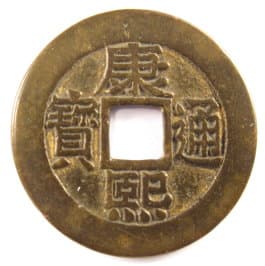
'Kang Xi Tong Bao' Coin
It has four Chinese characters (symbols). The characters on a typical Chinese coin are read in the following order: top, bottom, right, left.
The inscription (legend) on this coin would therefore be read as 康 (character at top), 熙 (character at bottom), 通 (character at right) and 寶 (character at left).
If you were to write these characters on one line you would write them from left to right as: 康熙通寶 (This particular coin, incidentally, has a very interesting history which is discussed at Ancient Chinese Coins with Charm Features.)
In the vast majority of cases, the character at the top and bottom refer to the "period title" (nianhao 年号) of the emperor under which the coin was cast. In this example, the "period title" is "康熙" (top character and bottom character) which means the coin was minted during the reign of the Kangxi Emperor (kangxi 康熙) of the Qing Dynasty.
In a few cases, the inscription is read clockwise beginning at the top which means the "period title" characters would be the top and right characters.
The other two characters (usually the right and left) on the coin have the general meaning of "currency" and do not really need to be translated.
However, if you wish to be very literal in your translation, these two "currency" characters can be translated as follows:
- 通寶 "universal currency" or "circulating currency" (pronounced tong bao)
- 元寶 "original currency" (pronounced yuan bao)
- 重寶 "heavy currency" (pronounced zhong bao)
(For an interesting story on the origin of these terms for "currency", please see the bottom of this page.)
On the above coin, the two characters meaning "currency" are the right (通) and left (寶) characters. The literal translation would thus be "universal currency" (tong bao 通寶).
As mentioned above, the inscriptions on a few coins are read clockwise beginning with the top character. In these cases, the two characters indicating "currency" would be the bottom and left characters.
How to Identify a Chinese Coin
Chinese cash coins (round copper or bronze coins with a square hole in the middle) were made for more than 2,000 years. There are hundreds of different types with thousands of varieties.
Of course, those who can read Chinese and are familiar with Chinese coins, or have reference books available, can easily identify a particular coin.
Identifying a Chinese coin can be a real challenge, however, if you cannot read Chinese and are not an experienced collector.
If you are not an "expert" but happen to have an old Chinese cash coin and would like to know a little more about it, the following simple guidelines may be helpful.
It is very likely that your coin is one of these common types:
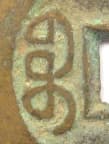
Qing dynasty coin
This character ("boo") is written not in Chinese but in the Manchu script. "Boo" translates as "building". However, when used in the inscription of Qing dynasty coins the character is a transliteration of the Chinese character bao (宝) meaning "treasure".
Some coins produced at the end of this dynasty were copper instead of bronze and were stamped by machines instead of cast in molds.
Please see Qing Dynasty Coins for examples of these coins along with historical information.
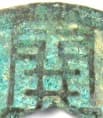
"Kai Yuan Tong Bao" coin
If the coin has the Chinese character 開, such as the example at the left, then it is a kai yuan tong bao
(開元通寶) from the Tang Dynasty (618-907).
Images and more information on this coin may be seen at Tang Dynasty Coins.

Han dynasty 'Wu Zhu' coin
Wu zhu coins were actually made over a period of about 700 years.
Many examples of this coin may be seen at Wu Zhu Coins.
Finally, if your coin is not one of the above then there is a very high probability that it is from the Northern Song Dynasty (960-1127).
Please see examples at Northern Song Coins and detailed historical information at Chinese Coins.
How to Read the Characters (Symbols) on a Chinese Charm
Similarly, most Chinese charms and amulets are also round with a square hole and have four Chinese characters on their obverse side.
Since charms and amulets are not legally circulating coins, most do not include the two "currency" characters mentioned above.
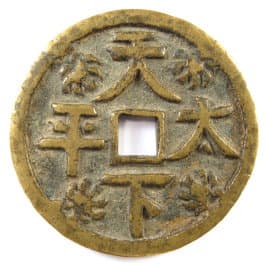
with Four Characters
The old charm to the left is a typical Chinese charm most likely cast during the Qing (Ch'ing) Dynasty. As is the case with the above cash coin, there are four Chinese characters (symbols) which are read in exactly the same way, i.e. top, bottom, right, left.
The legend would therefore be read as 天 (top), 下 (bottom), 太 (right) and 平 (left).
Written out on a single line from left to right the inscription would be 天下太平.
(This specific charm is discussed in detail at Ancient Chinese Peace Charms).
How to Find the Meaning of the Inscription
To help you understand the meanings of Chinese character (symbol) inscriptions or legends, I have created a list entitled Chinese Charm Inscriptions which includes many of the most common inscriptions you will see on Chinese charms and amulets.
A very small part of the list is shown at the bottom of this page for instructional purposes.
I considered several ways to group or categorize the inscriptions but all of these methods seemed to just complicate the matter.
Using the above example let us try to find the meaning of 天下太平.
The first column in the partial list below is "Charm Inscription" ("Charm Inscript").
In our example, this would be the Chinese characters in the order we determined: 天下太平.
You should scan down the "Charm Inscription" column looking for any inscription that begins with the first character of the inscription. In this example the first character is 天.
On the second row down you will see an inscription that begins with 天.
If you look at the second character of this entry you will discover that it is 官 which is not the second character (下) of our charm's legend.
Therefore, you must continue searching down the list.
On Row 3 you will find that the first character is 天 and the second character is 下.
You will also see that the third character (太) and the fourth character (平) are exactly the same as those of our charm.
Therefore, we have found the correct entry and the English translation in the fourth column says the meaning is "Peace under heaven".
There are many charms which have the same Chinese character(s) at the beginning so it is important to make sure that you find the one with all the characters in the proper sequence.
The second and third columns in the table are simply to provide you with a little additional information.
The second column is "Simplified Chinese" ("Simplify Chinese"). In order to make learning a little easier for the Chinese people, some of the more complicated Chinese characters which take many strokes to write have been "simplified" to have fewer strokes.
"Simplified Chinese" is the Chinese now used in China. You will see that in most cases the "charm inscription", which uses the old traditional way of writing characters and is still in use today in Hong Kong and Taiwan, is the same or very similar to the "simplified" version.
The third column provides the pronunciation ("Pronun.")of the inscription or legend using pinyin which is the romanization system used in China
The fourth column, as you have seen, provides the translation ("Translate").
How to read Two Character and Eight Character Inscriptions
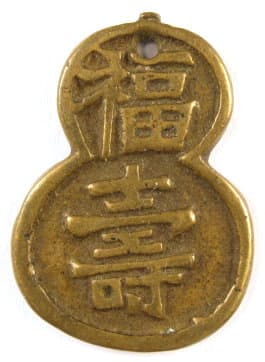
Two Character Inscription
Reading an inscription with two characters follows the same basic rules as reading a four character inscription.
In the example to the left, the characters should be read top to bottom: 福壽
To find the meaning you would search the first column looking for an entry beginning with 福 and with the second entry as 壽.
If you are successful in your search (Row 4), you should find that the meaning is "happiness and longevity".
This charm is discussed in more detail at gourd charms.
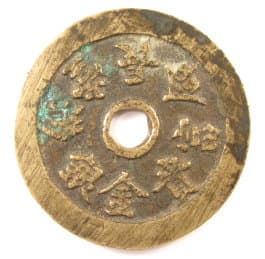
Eight Character Inscription
Some charms and amulets have eight character (symbol) inscriptions such as the example at the left.
In reality, these are just two inscriptions of four characters each.
Therefore, you would use the same technique we have just learned except that you will be doing it twice, once for each of the four character inscriptions.
Since the inscription is circular with equal spacing between characters the problem is discovering which Chinese character is the first character in either of the inscriptions.
There is no period, comma, or other punctuation to give you a clue.
This is not really unusual since ancient Chinese texts actually use no punctuation as we know it. Basically, you will just have to keep guessing and trying different characters to see which one successfully begins one of the four-character inscriptions in the list.
The only advice I can give as to discovering which is the first character in either of the two four-character inscriptions is to try to determine the "top" of the charm.
In the example to the left, you would not be able to decide this by looking at this side of the charm.
If you are fortunate, however, the other side of the charm may have pictures which would help you determine the "top".
Also, please note that on this particular charm all the Chinese characters are written with the bottom of the character at the outside rim and the top of the character at the round hole in the middle. As you hold this charm, only the Chinese character at the very bottom will be upright and in the proper position to read. To read the next character, just rotate the charm counterclockwise so that the next character is at the very bottom of the charm.
In this example, one of the four character inscriptions begins at the 12 o'clock position. Reading clockwise, the four characters are 長命富貴.
Following this inscription and continuing to read clockwise you will find that the second four-character inscription is 金銀滿堂.
According to the list of translations, the first four characters (Row 5) mean "longevity, wealth and honor" and the second four characters (row 6, not row 1) mean "may gold and silver fill your halls".
Please note that the second inscription (金銀滿堂) on this charm is found on Row 6 of the list and is slightly different from the inscription on Row 1 (金玉滿堂).
The only difference is the second character so it is important to make sure that all the characters are correct in their proper order.
In this particular example we were very "lucky" that one of the four character inscriptions began at the very top of the charm. In many cases this will not be the case and you will just have to try starting with another character until you are successful.
The reverse side of this charm happens to be most interesting. Please see "Eight Character Charms" at Charms with Auspicious Inscriptions for the discussion.
How to Read Inscriptions Written Horizontally
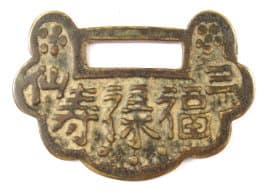
Written Horizontally
To the left is a lock charm with five Chinese characters (symbols). There are actually two inscriptions. One inscription is composed of the two smaller characters at the upper right (三) and the upper left (仙 ).
The second inscription consists of the three larger characters written across the main body of the charm.
When inscriptions are written horizontally they are read right to left, which is consistent with the way we have been reading the four character inscriptions (top, bottom, right, left).
For example, the two-character inscription on this charm is 三仙 (reading right to left) and not 仙三 (reading left to right).
When we are looking up the inscription in the list, however, the characters are still written left to right.
According to our translations below, the inscription (三仙) on Row 8 shows the meaning as "Three Immortals".
Similarly, the three-character inscription on the charm is read 福祿壽 (reading right to left) and not 壽祿福 (reading left to right).
The list (Row 7) informs us that the meaning is "happiness, emolument and longevity".
Incidentally, these lock charms have a very interesting history. Please see lock charms for a detailed discussion.
Hopefully, this little guide will enable you to read inscriptions and legends more easily and thereby allow you to have a better understanding of the deeper meaning of Chinese coins and charms.
(If you are interested in how the terms "tong bao", "yuan bao" and "zhong bao" came to be used in the inscriptions (legends) of Chinese coins to mean "currency", please continue reading to the bottom of this page).
Chinese Charm Inscriptions (Partial List)
For the complete list please see Chinese Charm Inscriptions
| Charm
Inscript |
Simplify
Chinese |
Pronun. |
Translate |
| 金玉滿堂 | 金玉满堂 | jin yu man tang | May gold and jade fill
your house (halls) |
| 天官賜福 |
天官赐福 | tian guan ci fu |
May the Ruler of Heaven
bestow good fortune |
| 天下太平 | 天下太平 | tian xia tai ping | Peace under heaven |
| 福壽 | 福寿 | fu shou | Happiness and longevity |
| 長命富貴 |
长命富贵 | chang ming fu gui |
Longevity, wealth and honor |
| 金銀滿堂 | 金银满堂 | jin yin man tang | May gold and silver fill your house (halls) |
| 福祿壽 | 福禄寿 | fu lu shou | Happiness, emolument and longevity |
| 三仙 |
三仙 |
san xian |
Three Immortals |
| 福如東海 |
福如东海 |
fu ru dong hai |
Fortune as vast as the
East Sea |
| 壽比南山 | 寿比南山 | shou bi nan shan |
Longevity as great as the
South Mountain |
Origin of "Tong Bao", "Yuan Bao" and "Zhong Bao"
There is an interesting story regarding the origin of the terms "tong bao" (通寶), "yuan bao" (元寶) and "zhong bao" (重寶) which were used in inscriptions (legends) to mean "currency" on Chinese coins for about 1,300 years.
I relate the story here because it illustrates that even native Chinese can have difficulty in understanding how Chinese coin inscriptions should be read.
A new type of coin appeared in the year 621 AD during the reign of Emperor Gaozu of the Tang Dynasty.
This coin marked the end of the 700 year long production of the wu zhu (五铢) coin. (Please see Emergence of Chinese Charms for many unusual examples of wu zhu.)
From this time on, Chinese currency would no longer be named after the "weight" of the coin such as had been the case with the ban liang, wu zhu, etc.
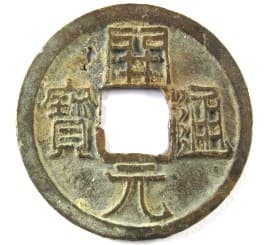
to use the term "tong bao"
to mean "currency"
The inscription was meant to be read in what had become the standard order of top character (kai 开), bottom character (yuan 元), right character (tong 通) and left character (bao 宝).
As explained in the sections of the guide above, the first two characters would normally be the "period title" (nianhao 年号) of the emperor under which the coin was cast. The people would, of course, be familiar with the "period title" in use by the emperor.
However, this was a new type of coin and the first two characters (kai yuan 开元), in this case, did not refer to Emperor Gaozu's period title which was actually Wu De (武德).
Kai yuan (开元) in this inscription has the meaning of "opening a new era" and the tong bao (通宝) was a new term meant to indicate "circulating treasure", "circulating currency" or "universal currency".
Since many people were not aware of this, they mistakenly read the coin legend in a clockwise manner as kai tong yuan bao (开通元宝) with yuan bao (元寶) having the meaning of "original currency".
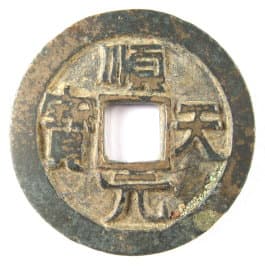
to use the term "yuan bao"
to mean "currency"
This "mistake", however, gradually became established as another term that could be used to mean "currency" and was then formally utilized on coins by Shi Siming (史思明 758-761 AD) who led a short-lived rebellion in northwest China during the Tang Dynasty.
At the left is a Shun Tian Yuan Bao (顺天元宝) issued in Luoyang in 759 by Shi Siming.
The inscription, in this case, is read in a clockwise manner beginning at the top.
The rebel Shi Siming was the first to use this new term "yuan bao" to mean "original currency".
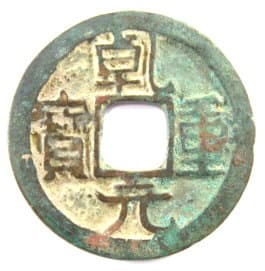
to use the term "zhong bao"
to mean "currency"
The final term used to mean "currency" in Chinese coin inscriptions was "zhong bao" (重寶) which can translate as "heavy currency".
This term was first used by another Tang Dynasty emperor, Emperor Suzong (唐肃宗 756-762 AD).
At the left is an example of the coin.
The inscription, read top to bottom and right to left, is qian yuan zhong bao (乾元重宝) and it was cast in the year 759 AD.
The "currency" terms "tong bao" (通寶), "yuan bao" (元寶) and "zhong bao" (重 寶) were established during a 138 year period of the Tang Dynasty (618-907). All three terms would continue to be used on Chinese coins to the very end of the Qing (Ch'ing) Dynasty in 1911.
Return to Ancient Chinese
Charms and Coins
